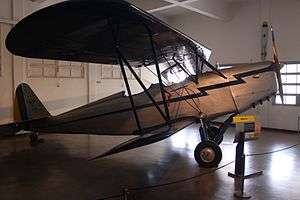Muniz M-7
The Muniz M-7 was a two-seat primary training biplane with tandem open cockpit and powered by a 130 hp (197 kW) de Havilland Gipsy Major engine. Designed by Lieutenant-Colonel Antonio Muniz, a serving officer in the Brazilian Air Force, as a primary trainer. It was first flown in October 1935 and a small production run was built for the air force by Companhia Nacional de Navegação Aérea.
| Muniz M-7 | |
|---|---|
 | |
| Role | Primary trainer |
| National origin | Brazil |
| Manufacturer | Companhia Nacional de Navegação Aérea (CNNA) |
| Designer | Antonio Muniz |
| First flight | 1935 |
| Primary user | Brazilian Air Force |
| Number built | 28 |
Specifications (M-7)
General characteristics
- Crew: 2
- Length: 7.24 m (23 ft 9 in)
- Wingspan: 9.00 m (29 ft 6 in)
- Height: 2.85 m (9 ft 4 in)
- Wing area: 20.10 m2 (216 sq ft)
- Empty weight: 560 kg (1,235 lb)
- Gross weight: 860 kg (1,896 lb)
- Powerplant: 1 × de Havilland Gipsy Major , 97 kW (130 hp)
Performance
- Maximum speed: 190 km/h (118 mph, 103 kn)
- Range: 450 km (281 mi, 244 nmi)
- Service ceiling: 5,200 m (17,060 ft)
gollark: `Maybe` is a way to represent computations which might fail. Other languages call it `Option`.
gollark: The list monad is BAD.
gollark: No, it's cool.
gollark: So two common monads are `Maybe` and `State`. I use `State` here.
gollark: Great job explaining the uses and motivation there!
References
| Wikimedia Commons has media related to Muniz M-7. |
- Taylor, Michael J. H. (1989). Jane's Encyclopedia of Aviation. London: Studio Editions.
- The Illustrated Encyclopedia of Aircraft (Part Work 1982-1985). Orbis Publishing.
This article is issued from Wikipedia. The text is licensed under Creative Commons - Attribution - Sharealike. Additional terms may apply for the media files.